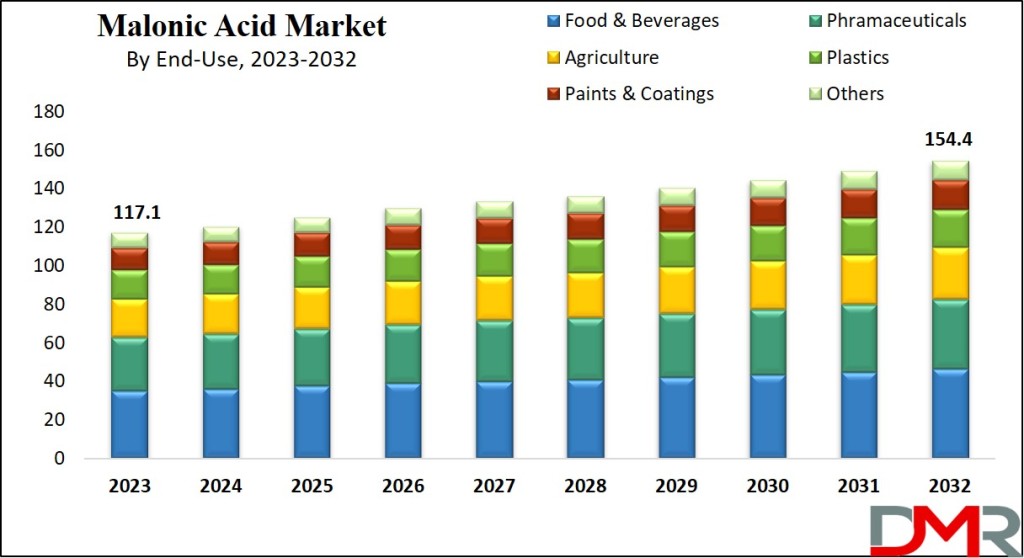Unveiling the Malonic Acid Market: A Comprehensive Analysis
Introduction
The Malonic Acid market is poised for significant growth, driven by its diverse applications across various industries. This article delves into the dynamics, growth prospects, and key drivers shaping the global Malonic Acid market.
Market Overview
The Global Malonic Acid market is projected to reach a valuation of USD 117.1 million by 2023, with a steady CAGR of 3.1% anticipated during the forecast period from 2023 to 2032. Malonic acid, with the chemical formula C3H4O4, serves as an essential organic dicarboxylic acid, finding extensive use in numerous chemical processes.

Get a Free PDF Sample Copy of This Report@ https://dimensionmarketresearch.com/report/Malonic-Acid-Market/request-sample
Understanding Malonic Acid
Malonic acid appears as a white crystalline solid, easily soluble in water and polar organic solvents. Its chemical versatility, attributed to its dual carboxylic acid groups, enables its participation in various chemical reactions, including condensation, esterification, and decarboxylation reactions.
Role in Agriculture
The agricultural sector emerges as a major driver for the Malonic Acid market. As a precursor for insecticides, herbicides, and fungicides, malonic acid plays a crucial role in crop protection products. Additionally, its efficacy as a buffer and pH adjuster enhances its value in agricultural formulations.
Market Dynamics
Key Market Trends
The United States represents a significant market for malonic acid, driven by demand from the food additives, pharmaceutical, and cosmetic sectors. A notable trend in the chemical industry is the increasing focus on incorporating renewable raw materials for malonic acid manufacturing, reflecting a shift towards eco-friendly practices.
Sustainable Practices
The adoption of environmentally friendly manufacturing techniques and technologies propels market growth, positioning the United States as a major player in the Malonic Acid market. The industry's commitment to sustainability drives demand across various end-use sectors.
Key Takeaways:
- Market Growth: The Malonic Acid market is poised for steady growth, driven by its diverse applications in agriculture, food, pharmaceuticals, and other industries.
- Versatile Applications: Malonic acid serves as a fundamental raw material in chemical processes, playing roles such as a precursor for insecticides, herbicides, and flavor enhancers in the food and beverage sector.
- Sustainability: Increasing focus on eco-friendly manufacturing techniques and renewable raw materials underscores the industry's commitment to sustainability, driving demand for malonic acid.
- Regional Opportunities: Europe and North America emerge as key regions for market expansion, fueled by advancements in sustainable practices and rising demand across various end-use sectors.
Recent Developments (2023-2024):
- Growing Pharmaceutical Demand: The pharmaceutical industry's increasing demand for malonic acid as a key intermediate in drug production is expected to be a major driver of market growth.
- Shift Towards Bio-based Production: Growing interest in sustainable practices is leading to the development of bio-based malonic acid from sources like sugar and glycerol.
- Focus on Specialty Chemicals: Increased usage in flavors, fragrances, and dyes applications is contributing to market expansion.
- Market Size and Growth Projections: Estimates suggest the global Malonic Acid market reached USD 108.1 million in 2022 and is projected to reach USD 140.3 million by 2030, with a CAGR of 2.9%.
Buy This Exclusive Report Here@ https://dimensionmarketresearch.com/checkout/Malonic-Acid-Market
Research Scope and Analysis
Application Insights
The flavor enhancer segment dominates the Malonic Acid market, owing to its extensive utilization in the food and beverage sector. Malonic acid serves as a flavoring agent, acidulant, and precursor to polyesters, contributing to its significant market share.
End-Use Analysis
The food and beverage segment captures a substantial share of the market, driven by the rising demand for flavoring agents and additives. Moreover, malonic acid's role in pharmaceuticals and plant growth regulators further propels market demand.
FAQs (Frequently Asked Questions)
1. What are the primary applications of malonic acid?
Malonic acid serves as a precursor for insecticides, herbicides, and fungicides in the agricultural sector, along with its usage as a flavor enhancer and acidulant in the food and beverage industry.
2. How does malonic acid contribute to sustainable practices in the chemical industry?
Malonic acid's versatility and eco-friendly manufacturing processes position it as a key driver in promoting sustainable substitutes in the chemical industry, fostering environmental consciousness.
3. Which regions exhibit substantial growth prospects for the malonic acid market?
Europe and North America showcase promising growth opportunities, driven by advancements in environmentally friendly manufacturing techniques and increasing demand across end-use sectors.
4. What role does malonic acid play in the food and beverage industry?
Malonic acid serves as a flavor enhancer, acidulant, and additive in the food and beverage sector, enhancing taste and acidity in various food products, thereby contributing to its widespread usage.
5. How does malonic acid contribute to crop protection products?
Malonic acid acts as a buffer and pH adjuster in agricultural formulations, improving the efficacy of crop protection products and enhancing overall crop yield.
Conclusion
The Malonic Acid market presents lucrative opportunities for stakeholders across diverse industries. With its versatility, sustainability, and widespread applications, malonic acid is poised to play a pivotal role in shaping the future of the chemical industry. Embracing innovation and sustainable practices will be key to unlocking its full potential in the years to come.











Comments (0)